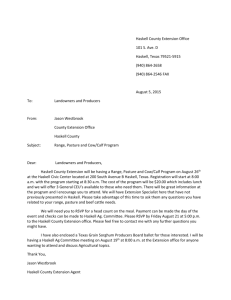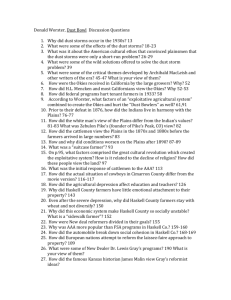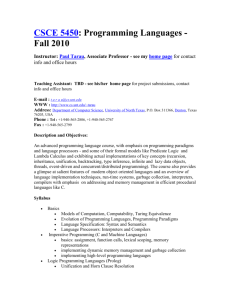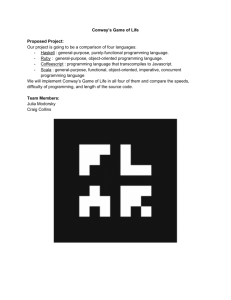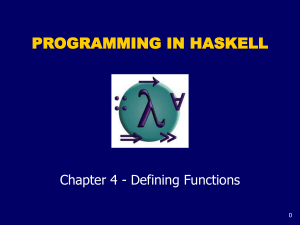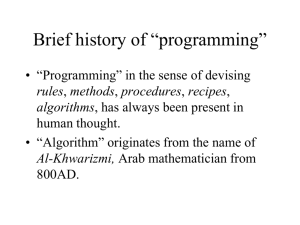HaskellIntro
advertisement
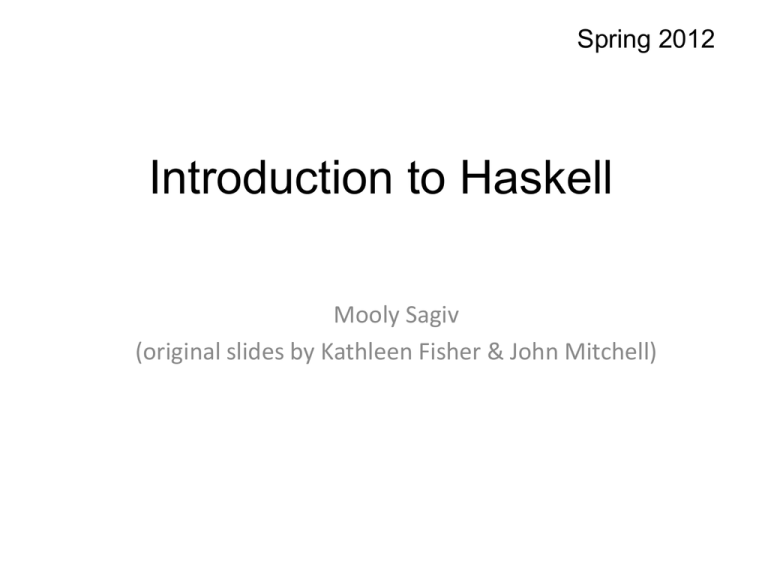
Spring 2012
Introduction to Haskell
Mooly Sagiv
(original slides by Kathleen Fisher & John Mitchell)
Lambda Calculus
Computation Models
• Turing Machines
• Wang Machines
• Lambda Calculus
Untyped Lambda Calculus
Chapter 5
Benjamin Pierce
Types and Programming Languages
Basics
• Repetitive expressions can be compactly
represented using functional abstraction
• Example:
– (5* 4* 3 * 2 * 1) + (7 * 6 * 5 * 4 * 3 * 2 *1) =
– factorial(5) + factorial(7)
– factorial(n) = if n = 0 then 1 else n * factorial(n-1)
– factorial= n. if n = 0 then 0 else n factorial(n-1)
Untyped Lambda Calculus
t ::=
terms
x
variable
x. t
abstraction
tt
application
Terms can be represented as abstract syntax trees
Syntactic Conventions
• Applications associates to left
e1 e2 e3 (e1 e2) e3
• The body of abstraction extends as far as possible
• x. y. x y x x. (y. (x y) x)
Free vs. Bound Variables
• An occurrence of x is free in a term t if it is not in the
body on an abstraction x. t
– otherwise it is bound
– x is a binder
• Examples
– z. x. y. x (y z)
– (x. x) x
• Terms w/o free variables are combinators
– Identify function: id = x. x
Operational Semantics
( x. t12) t2 [x t2] t12 (-reduction)
redex
( x. x) y
y
( x. x ( x. x) ) (u r) u r ( x.x)
( x (w. x w)) (y z) w. y z w
Evaluation Orders
( x. t12) t2 [x t2] t12 (-reduction)
( x. x) ((x. x) (z. (x. x) z))
id (id (z. id z))
id (id (z. id z)) id (id (z. id z))
z. z
z. id z
id (z. id z)
call-by-value
z. id z
id (z. id z)
call-by-name
Normal order
id (z. id z)
id (id (z. id z))
z. id z
Lambda Calculus vs. JavaScript
( x. x) y
(function (x) {return x;}) y
Programming in the Lambda Calculus
Multiple arguments
• f= (x, y). s
• Currying
• f= x. y.s
fvw=
(f v) w =
(x. y.s v) w
y.[x v]s)
w)
[x v] [y w] s
Programming in the Lambda Calculus
Church Booleans
•
•
•
•
tru = t. f. t
fls =t. f. f
test =l. m. n. l m n
and = b. c. b c fls
Programming in the Lambda Calculus
Pairs
• pair = f. b. s. b f s
• fst = p. p tru
• snd = p. p fls
Programming in the Lambda Calculus
Numerals
•
•
•
•
•
•
•
•
c0 = f. z. z
c1 =f. z. s z
c2 = f. z. s (s z)
c3 = f. z. s (s (s z))
scc = n. s. z. s (n s z)
plus = m. n. s. z. m s (n s z)
times = m. n. m (plus n) c0
Turing Complete
Divergence in Lambda Calculus
• omega= (x. x x) (x. x x)
• fix = f. (x. f ( y. x x y)) (x. f ( y. x x y))
Operational Semantics
( x. t12) t2 [x t2] t12 (-reduction)
FV: t P(Var) is the set free variables of t
FV(x) = {x}
FV( x. t) = FV(t) – {x}
FV (t1 t2) = FV(t1) FV(t2)
[xs]x =s
[x s]y=y
if y x
[x s ] (y. t1) = y. [x s ] t1
if y x and yFV(s)
[x s ] (t1 t2) = ([x s ] t1) ([x s ] t2)
Call-by-value Operational Semantics
t ::=
terms
x
variable
x. t
abstraction
tt
application
v ::=
x.
values
abstraction values
( x. t12) v2 [x v2] t12 (E-AppAbs)
t1 t’1
t1 t2 t’1 t2
t2 t’2
v1 t2 v1 t’2
(E-APPL1)
(E-APPL2)
Extending the Lambda Calculus
• Primitive values
• Exceptions
• References
Summary Lambda Calculus
•
•
•
•
•
Powerful
Useful to illustrate ideas
But can be counterintuitive
Usually extended with useful syntactic sugars
Other calculi exist
–
–
–
–
pi-calculus
object calculus
mobile ambients
…
Language Evolution
Lisp
Algol 60
Simula
Algol 68
Pascal
C
Smalltalk
ML
Haskell
Modula
C++
Java
Many others: Algol 58, Algol W, Scheme, EL1, Mesa (PARC), Modula-2,
Oberon, Modula-3, Fortran, Ada, Perl, Python, Ruby, C#, Javascript, F#…
C Programming Language
Dennis Ritchie, ACM Turing Award for Unix
• Statically typed, general purpose systems programming
language
• Computational model reflects underlying machine
• Relationship between arrays and pointers
– An array is treated as a pointer to first element
– E1[E2] is equivalent to ptr dereference: *((E1)+(E2))
– Pointer arithmetic is not common in other languages
• Not statically type safe
• Ritchie quote
– “C is quirky, flawed, and a tremendous success”
ML programming language
• Statically typed, general-purpose programming language
– “Meta-Language” of the LCF theorem proving system
• Type safe, with formal semantics
• Compiled language, but intended for interactive use
• Combination of Lisp and Algol-like features
–
–
–
–
–
–
Expression-oriented
Higher-order functions
Garbage collection
Abstract data types
Module system
Exceptions
• Used in printed textbook as example language
Robin Milner, ACM Turing-Award for ML, LCF Theorem Prover, …
Haskell
• Haskell programming language is
– Similar to ML: general-purpose, strongly typed, higher-order,
functional, supports type inference, interactive and compiled use
– Different from ML: lazy evaluation, purely functional core, rapidly
evolving type system
• Designed by committee in 80’s and 90’s to unify research
efforts in lazy languages
– Haskell 1.0 in 1990, Haskell ‘98, Haskell’ ongoing
– “A History of Haskell: Being Lazy with Class” HOPL 3
Paul Hudak
John Hughes
Simon
Peyton Jones
Phil Wadler
Haskell B Curry
• Combinatory logic
– Influenced by Russell and Whitehead
– Developed combinators to represent
substitution
– Alternate form of lambda calculus that has
been used in implementation structures
• Type inference
– Devised by Curry and Feys
– Extended by Hindley, Milner
Although “Currying” and “Curried functions” are
named after Curry, the idea was invented by
Schoenfinkel earlier
Why Study Haskell?
• Good vehicle for studying language concepts
• Types and type checking
–
–
–
–
General issues in static and dynamic typing
Type inference
Parametric polymorphism
Ad hoc polymorphism (aka, overloading)
• Control
– Lazy vs. eager evaluation
– Tail recursion and continuations
– Precise management of effects
Why Study Haskell?
• Functional programming will make you think
differently about programming.
– Mainstream languages are all about state
– Functional programming is all about values
• Haskell is “cutting edge”
– A lot of current research is done using Haskell
– Rise of multi-core, parallel programming likely to
make minimizing state much more important
• New ideas can help make you a better
programmer, in any language
Practitioners
Most Research Languages
1,000,000
10,000
Geeks
100
The quick death
1
1yr
5yr
10yr
15yr
Practitioners
Successful Research Languages
1,000,000
10,000
Geeks
100
The slow death
1
1yr
5yr
10yr
15yr
Practitioners
C++, Java, Perl, Ruby
Threshold of immortality
1,000,000
10,000
The complete
absence of death
Geeks
100
1
1yr
5yr
10yr
15yr
Practitioners
Haskell
1,000,000
10,000
“I'm already looking at coding
problems and my mental
perspective is now shifting
back and forth between purely
OO and more FP styled
solutions”
(blog Mar 2007)
Geeks
100
“Learning Haskell is a great way of
training yourself to think functionally so
you are ready to take full advantage of
C# 3.0 when it comes out”
(blog Apr 2007)
The second life?
1
1990
1995
2000
2005
2010
Function Types in Haskell
In Haskell, f :: A B means for every x A,
f(x) =
some element y = f(x) B
run forever
In words, “if f(x) terminates, then f(x) B.”
In ML, functions with type A B can throw an
exception or have other effects, but not in Haskell
Higher Order Functions
• Functions are first class objects
– Passed as parameters
– Returned as results
• Practical examples
– Google map/reduce
Example Higher Order Function
• The differential operator
Df = f’ where f’(x) = lim ho (f(x+h)-f(x))/h
• In Haskel
diff f = f_
where
f_ x = (f (x +h) – f x) / h
h = 0.0001
• diff :: (float -> float) -> (float -> float)
• (diff square) 0 = 0.0001
• (diff square) 0.0001 = 0.0003
• (diff (diff square)) 0 = 2
Basic Overview of Haskell
• Interactive Interpreter (ghci): read-eval-print
– ghci infers type before compiling or executing
– Type system does not allow casts or other loopholes!
• Examples
Prelude> (5+3)-2
6
it :: Integer
Prelude> if 5>3 then “Harry” else “Hermione”
“Harry”
it :: [Char]
-- String is equivalent to [Char]
Prelude> 5==4
False
it :: Bool
Overview by Type
• Booleans
True, False :: Bool
if … then … else …
--types must match
• Integers
0, 1, 2, … :: Integer
+, * , …
:: Integer
-> Integer -> Integer
• Strings
“Ron
Weasley”
• Floats
1.0, 2, 3.14159, …
--type classes to disambiguate
Simple Compound Types
Tuples
(4, 5, “Griffendor”) :: (Integer, Integer, String)
Lists
[] :: [a]
-- polymorphic type
1 : [2, 3, 4] :: [Integer]
-- infix cons notation
Records
data Person = Person {firstName :: String,
lastName :: String}
hg = Person { firstName = “Hermione”,
lastName = “Granger”}
Patterns and Declarations
• Patterns can be used in place of variables
<pat> ::= <var> | <tuple> | <cons> | <record> …
• Value declarations
– General form:
– Examples
<pat> = <exp>
myTuple = (“Flitwick”, “Snape”)
(x,y) = myTuple
myList = [1, 2, 3, 4]
z:zs = myList
– Local declarations
• let (x,y) = (2, “Snape”) in x * 4
Functions and Pattern Matching
• Anonymous function
\x -> x+1
--like Lisp lambda, function (…) in JS
• Function declaration form
<name> <pat1> = <exp1>
<name> <pat2> = <exp2> …
<name> <patn> = <expn> …
• Examples
(x,y) =
flength
[]
x+y
--argument must match pattern (x,y)
= 0
length (x:s) = 1 + length(s)
Map Function on Lists
• Apply function to every element of list
map f [] = []
map f (x:xs) = f x : map f xs
map (\x -> x+1) [1,2,3]
[2,3,4]
• Compare to Lisp
(define map
(lambda (f xs)
(if
(eq? xs ()) ()
(cons (f (car xs))
)))
(map f
(cdr xs)))
More Functions on Lists
• Append lists
–
append
append
–
([], ys) = ys
(x:xs, ys) = x : append (xs, ys)
• Reverse a list
–reverse
–reverse
[] = []
(x:xs) = (reverse xs) ++ [x]
• Questions
– How efficient is reverse?
– Can it be done with only one pass through list?
More Efficient Reverse
reverse xs =
let rev ( [], accum ) = accum
rev ( y:ys, accum ) = rev ( ys, y:accum )
in rev ( xs, [] )
1
3
2
2
3
3
1
3
2
2
1
1
List Comprehensions
• Notation for constructing new lists from old:
myData = [1,2,3,4,5,6,7]
twiceData = [2 * x | x <- myData]
-- [2,4,6,8,10,12,14]
twiceEvenData = [2 * x| x <- myData, x `mod` 2 == 0]
-- [4,8,12]
• Similar to “set comprehension”
{ x | x Odd x > 6 }
Datatype Declarations
• Examples
– data
Color = Red | Yellow | Blue
elements are Red, Yellow, Blue
data Atom = Atom String | Number Int
elements are Atom “A”, Atom “B”, …, Number 0, ...
data List
= Nil
|
Cons (Atom, List)
elements are Nil, Cons(Atom “A”, Nil), …
Cons(Number 2, Cons(Atom(“Bill”), Nil)), ...
• General form
– data <name> = <clause> | … | <clause>
<clause> ::= <constructor> | <contructor> <type>
– Type name and constructors must be Capitalized
Datatypes and Pattern Matching
Recursively defined data structure
data Tree = Leaf Int | Node (Int, Tree, Tree)
Node(4, Node(3, Leaf 1, Leaf 2),
Node(5, Leaf 6, Leaf 7))
4
3
1
5
2
Recursive function
sum (Leaf n) = n
sum (Node(n,t1,t2)) = n + sum(t1) + sum(t2)
6
7
Example: Evaluating Expressions
• Define datatype of expressions
data Exp = Var Int | Const Int | Plus (Exp, Exp)
write (x+3)+ y as Plus(Plus(Var 1, Const 3), Var 2)
• Evaluation function
ev(Var n) = Var n
ev(Const n ) = Const n
ev(Plus(e1,e2)) = …
• Examples
ev(Plus(Const 3, Const 2))
Const 5
ev(Plus(Var 1, Plus(Const 2, Const 3)))
Plus(Var 1, Const 5)
Case Expression
Datatype
data Exp = Var Int | Const Int | Plus (Exp, Exp)
Case expression
case e of
Var n -> …
Const n -> …
Plus(e1,e2) -> …
Indentation matters in case statements in Haskell
Offside rule
• Layout characters matter to parsing
divide x 0 = inf
divide x y = x / y
• Everything below and right of = in equations defines a new
scope
• Applied recursively
fac n = if (n ==0) then 1 else prod n (n-1)
where
prod acc n = if (n == 0) then acc
else prod (acc * n) (n -1)
• Lexical analyzer maintains a stack
Evaluation by Cases
data Exp = Var Int | Const Int | Plus (Exp, Exp)
ev ( Var n) = Var n
ev ( Const n ) = Const n
ev ( Plus ( e1,e2 ) ) =
case ev e1 of
Var n -> Plus( Var n, ev e2)
Const n -> case ev e2 of
Var m -> Plus( Const n, Var m)
Const m -> Const (n+m)
Plus(e3,e4) -> Plus ( Const n,
Plus ( e3, e4 ))
Plus(e3, e4) -> Plus( Plus ( e3, e4 ), ev e2)
Polymorphic Typing
• Polymorphic expression has many types
• Benefits:
– Code reuse
– Guarantee consistency
• The compiler infers that in
length [] = 0
length (x: xs) = 1 + length xs
– length has the type [a] -> int
length :: [a] -> int
• Example expressions
– length [1, 2, 3] + length [“red”, “yellow”, “green”]
– length [1, 2, “green” ] // invalid list
• The user can optionally declare types
• Every expression has the most general type
• “boxed” implementations
Laziness
Haskell is a lazy language
Functions and data constructors don’t
evaluate their arguments until they need
them
cond :: Bool -> a -> a -> a
cond True t e = t
cond False t e = e
Programmers can write control-flow operators
that have to be built-in in eager languages
Shortcircuiting
“or”
(||) :: Bool -> Bool -> Bool
True || x = True
False || x = x
Using Laziness
isSubString :: String -> String -> Bool
x `isSubString` s = or [ x `isPrefixOf` t
| t <- suffixes s ]
suffixes:: String -> [String]
type String = [Char]
-- All suffixes of s
suffixes[]
= [[]]
suffixes(x:xs) = (x:xs) : suffixes xs
or
-or
or
:: [Bool] -> Bool
(or bs) returns True if any of the bs is True
[]
= False
(b:bs) = b || or bs
A Lazy Paradigm
• Generate all solutions (an enormous tree)
• Walk the tree to find the solution you want
nextMove :: Board -> Move
nextMove b = selectMove allMoves
where
allMoves = allMovesFrom b
A gigantic (perhaps infinite)
tree of possible moves
Benefits of Lazy Evaluation
• Define streams
main = take 100 [1 .. ]
• deriv f x = lim [(f (x + h) – f x) / h | h <- [1/2^n | n <- [1..]]]
where lim (a: b: lst) = if abs(a/b -1) < eps then b
else lim (b: lst)
eps = 1.0 e-6
• Lower asymptotic complexity
• Language extensibility
– Domain specific languages
• But some costs
Core Haskell
• Basic Types
–
–
–
–
–
–
–
–
Unit
Booleans
Integers
Strings
Reals
Tuples
Lists
Records
•
•
•
•
•
•
•
•
Patterns
Declarations
Functions
Polymorphism
Type declarations
Type Classes
Monads
Exceptions
Functional Programming Languages
PL
types
evaluation
Side-effect
scheme
Weakly typed
Eager
yes
ML
OCAML
F#
Polymorphic
strongly typed
Eager
References
Haskel
Polymorphic
strongly typed
Lazy
None
Compiling Functional Programs
Compiler Phase
Language Aspect
Lexical Analyzer
Offside rule
Parser
List notation
List comprehension
Pattern matching
Context Handling
Polymorphic type checking
Run-time system
Referential transparency
Higher order functions
Lazy evaluation
Structure of a functional compiler
High-level language
Polymorphic type
De-sugaring:
inference
1. Pattern matching
2. List to pairs
Optimizations
3. List
comprehension
4. Lambda lifting
Functional core
Code generation
C code
Runtime
system
QuickCheck
• Generate random input based on type
– Generators for values of type a has type Gen a
– Have generators for many types
• Conditional properties
– Have form <condition> ==> <property>
– Example:
ordered xs = and (zipWith (<=) xs (drop 1 xs))
insert x xs = takeWhile (<x) xs++[x]++dropWhile (<x) xs
prop_Insert x xs =
ordered xs ==> ordered (insert x xs)
where types = x::Int
QuickCheck
• QuickCheck output
– When property succeeds:
quickCheck prop_RevRev OK, passed 100 tests.
– When a property fails, QuickCheck displays a counter-example.
prop_RevId xs = reverse xs == xs where types = xs::[Int]
quickCheck prop_RevId
Falsifiable, after 1 tests: [-3,15]
• Conditional testing
– Discards test cases which do not satisfy the condition.
– Test case generation continues until
• 100 cases which do satisfy the condition have been found, or
• until an overall limit on the number of test cases is reached (to
avoid looping if the condition never holds).
See : http://www.cse.chalmers.se/~rjmh/QuickCheck/manual.html
Things to Notice
No side effects. At all
reverse:: [w] -> [w]
A call to reverse returns a new list; the old one
is unaffected
prop_RevRev l = reverse(reverse l) == l
A variable ‘l’ stands for an immutable value,
not for a location whose value can change
Laziness forces this purity
Things to Notice
• Purity makes the interface explicit.
reverse:: [w] -> [w]
-- Haskell
• Takes a list, and returns a list; that’s all.
void reverse( list l )
/* C */
• Takes a list; may modify it; may modify other
persistent state; may do I/O.
Things to Notice
• Pure functions are easy to test
prop_RevRev l = reverse(reverse l) == l
• In an imperative or OO language, you have to
– set up the state of the object and the external state it
reads or writes
– make the call
– inspect the state of the object and the external state
– perhaps copy part of the object or global state, so that
you can use it in the post condition
Things to Notice
Types are everywhere.
reverse:: [w] -> [w]
• Usual static-typing panegyric omitted...
• In Haskell, types express high-level design, in
the same way that UML diagrams do, with
the advantage that the type signatures are
machine-checked
• Types are (almost always) optional: type
inference fills them in if you leave them out
More Info: haskell.org
• The Haskell wikibook
– http://en.wikibooks.org/wiki/Haskell
• All the Haskell bloggers, sorted by topic
– http://haskell.org/haskellwiki/Blog_articles
• Collected research papers about Haskell
– http://haskell.org/haskellwiki/Research_papers
• Wiki articles, by category
– http://haskell.org/haskellwiki/Category:Haskell
•
Books and tutorials
– http://haskell.org/haskellwiki/Books_and_tutorials
Summary
• Functional programs provide concise coding
• Compiled code compares with C code
• Successfully used in some commercial
applications
– F#, ERLANG
•
•
•
•
Ideas used in imperative programs
Good conceptual tool
Less popular than imperative programs
Haskel is a well thought functional language

